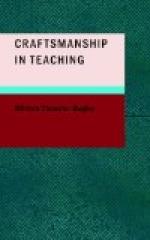II
I shall not try in this discussion of the problem of study to summarize completely the principles and precepts that have been presented so well in the four books on the subject that have appeared in the last two years. I do not know, in fact, of any book that is more useful to the teacher just at present than Professor Frank McMurry’s How to Study and Teaching how to Study. It is a book that is both a help and a delight, for it is clear and well-organized, and written in a vivacious style and with a wealth of concrete illustration that holds the attention from beginning to end. The chief fault that I have to find with it is the fault that I have to find with almost every educational book that comes from the press to-day,—the tendency, namely, to imply that the teacher of to-day is doing very little to solve these troublesome problems. As a matter of fact, many teachers are securing excellent results from their attempts to teach pupils how to study. Otherwise we should not find so many energetic young men to-day who are making an effective individual mastery of the principles of their respective trades and professions independently of schools and teachers. Our attitude toward these questions, far from being that of the pessimist, should be that of the optimist. Our task should be to seek out these successful teachers, and find out how they do their work.
Among the most important points emphasized by the recent writers upon the art of study is the necessity for some form of motivation in the work of mastering the text. We all know that if a pupil feels a distinct need for getting information out of a book, the chances are that he will get it if the book is available and if he can read. To create a problem that will involve in its solution the gaining of such information is, therefore, one of the best approaches to a mastery of the art of study. It is, however, only the beginning. It furnishes the necessary energy, but does not map out the path along which this energy is to be expended. And this is where the greater emphasis, perhaps, is needed.




